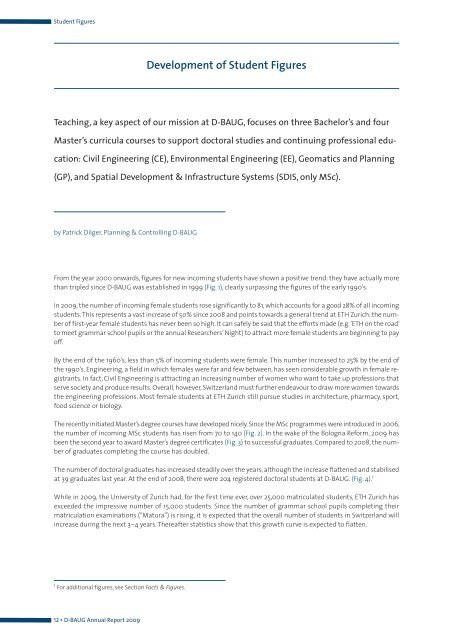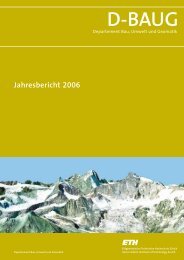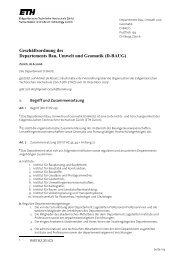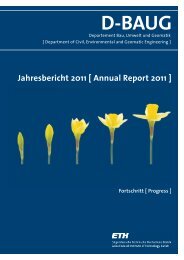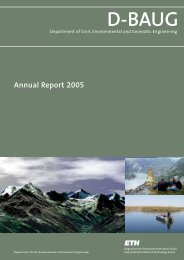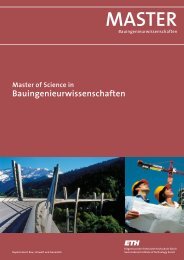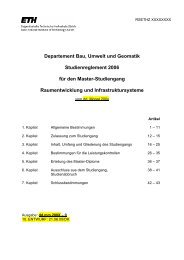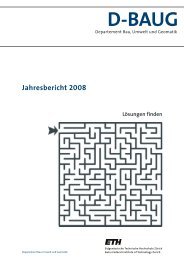D-BAUG - Departement Bau, Umwelt und Geomatik - ETH Zürich
D-BAUG - Departement Bau, Umwelt und Geomatik - ETH Zürich
D-BAUG - Departement Bau, Umwelt und Geomatik - ETH Zürich
You also want an ePaper? Increase the reach of your titles
YUMPU automatically turns print PDFs into web optimized ePapers that Google loves.
Student Figures<br />
1 For additional figures, see Section Facts & Figures.<br />
12 ▪ D-<strong>BAUG</strong> Annual Report 2009<br />
Development of Student Figures<br />
Teaching, a key aspect of our mission at D-<strong>BAUG</strong>, focuses on three Bachelor’s and four<br />
Master’s curricula courses to support doctoral studies and continuing professional edu-<br />
cation: Civil Engineering (CE), Environmental Engineering (EE), Geomatics and Planning<br />
(GP), and Spatial Development & Infrastructure Systems (SDIS, only MSc).<br />
by Patrick Dilger, Planning & Controlling D-<strong>BAUG</strong><br />
From the year 2000 onwards, figures for new incoming students have shown a positive trend: they have actually more<br />
than tripled since D-<strong>BAUG</strong> was established in 1999 (Fig. 1), clearly surpassing the figures of the early 1990’s.<br />
In 2009, the number of incoming female students rose significantly to 81, which accounts for a good 28% of all incoming<br />
students.This represents a vast increase of 50% since 2008 and points towards a general trend at <strong>ETH</strong> Zurich: the number<br />
of first-year female students has never been so high. It can safely be said that the efforts made (e.g.‘<strong>ETH</strong> on the road’<br />
to meet grammar school pupils or the annual Researchers’ Night) to attract more female students are beginning to pay<br />
off.<br />
By the end of the 1960’s, less than 5% of incoming students were female. This number increased to 25% by the end of<br />
the 1990’s. Engineering, a field in which females were far and few between, has seen considerable growth in female registrants.<br />
In fact, Civil Engineering is attracting an increasing number of women who want to take up professions that<br />
serve society and produce results. Overall, however, Switzerland must further endeavour to draw more women towards<br />
the engineering professions. Most female students at <strong>ETH</strong> Zurich still pursue studies in architecture, pharmacy, sport,<br />
food science or biology.<br />
The recently initiated Master’s degree courses have developed nicely. Since the MSc programmes were introduced in 2006,<br />
the number of incoming MSc students has risen from 70 to 140 (Fig. 2). In the wake of the Bologna Reform, 2009 has<br />
been the second year to award Master’s degree certificates (Fig. 3) to successful graduates. Compared to 2008, the number<br />
of graduates completing the course has doubled.<br />
The number of doctoral graduates has increased steadily over the years, although the increase flattened and stabilised<br />
at 39 graduates last year. At the end of 2008, there were 204 registered doctoral students at D-<strong>BAUG</strong>. (Fig. 4). 1<br />
While in 2009, the University of Zurich had, for the first time ever, over 25,000 matriculated students, <strong>ETH</strong> Zurich has<br />
exceeded the impressive number of 15,000 students. Since the number of grammar school pupils completing their<br />
matriculation examinations (“Matura”) is rising, it is expected that the overall number of students in Switzerland will<br />
increase during the next 3–4 years. Thereafter statistics show that this growth curve is expected to flatten.


